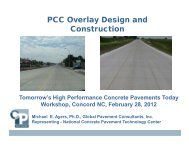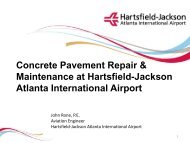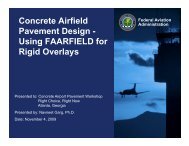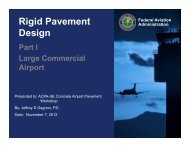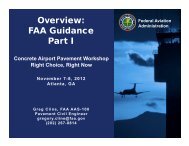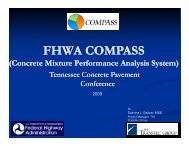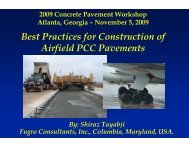Airfield Concrete Pavement S th Smoothness
Airfield Concrete Pavement S th Smoothness
Airfield Concrete Pavement S th Smoothness
You also want an ePaper? Increase the reach of your titles
YUMPU automatically turns print PDFs into web optimized ePapers that Google loves.
<strong>Airfield</strong> <strong>Concrete</strong> <strong>Pavement</strong><br />
Smoo<strong>th</strong>ness<br />
October 27‐28, 2010<br />
Presented by:<br />
Mr. Tony Gerardi<br />
APR Consultants, Inc.
The Primary Reason We Strive to Build<br />
and Maintain Smoo<strong>th</strong> <strong>Pavement</strong>s is to<br />
Minimize Aircraft Dynamic Response,<br />
and Maximize Aircraft Performance
Roughness Defined<br />
1. Shock Loading<br />
Short waveleng<strong>th</strong> roughness <strong>th</strong>at is too fast for <strong>th</strong>e tires and<br />
suspension system to fully react. (rattles instruments, t jars<br />
avionics)<br />
2. Single Axle Loading<br />
Short waveleng<strong>th</strong> roughness <strong>th</strong>at <strong>th</strong>e tires and suspension system<br />
are capable of reacting to. (Increases O&S costs, passenger<br />
complaints)<br />
3. Whole Aircraft Loading<br />
Longer waveleng<strong>th</strong> roughness <strong>th</strong>at excites <strong>th</strong>e whole aircraft<br />
(Aircraft fatigue damage, reduces braking ability, reduces<br />
pavement life)<br />
Note: Types (1) and (2) can be detected by a 16’ Straightedge or<br />
a Profilograph; Type (3) cannot
Why Be Concerned About Runway<br />
Roughness<br />
Aborted<br />
Takeoff<br />
Poor Braking<br />
Performance<br />
Increased Operational &<br />
Support Costs & Aircraft Fatigue Damage<br />
Reduces <strong>Pavement</strong>’s Useful Life and<br />
Could Result in Costly Unscheduled Repairs<br />
Pilot and Passenger Complaints
IPRF Research on Airport <strong>Pavement</strong> Smoo<strong>th</strong>ness:<br />
Research Goals ‐ IPRF 02‐4<br />
1. Develop a smoo<strong>th</strong>ness handbook for all<br />
stakeholders<br />
2. Overview of capabilities for off <strong>th</strong>e shelf profiler<br />
types to capture data for 16’ straightedge use<br />
3. Develop target smoo<strong>th</strong>ness criteria<br />
4. Identify construction practices <strong>th</strong>at result in<br />
smoo<strong>th</strong> pavements
New <strong>Pavement</strong> Acceptance Specifications<br />
• FAA AC‐150/5370; (P‐501) 16‐Foot Straightedge<br />
using a .25 inch maximum allowable deviation<br />
anywhere along <strong>th</strong>e straightedge.<br />
• California Profilograph; Typical specification is a PI of<br />
5‐7 inches per mile<br />
• Bo<strong>th</strong> me<strong>th</strong>ods will produce a smoo<strong>th</strong> ride if grade<br />
control is maintained.<br />
• APR’s experience shows bo<strong>th</strong> me<strong>th</strong>ods to be<br />
conservative
Evolution of Airport <strong>Pavement</strong> Smoo<strong>th</strong>ness 16‐<br />
Foot Straightedge<br />
“Max Deviation Anywhere Along <strong>th</strong>e Leng<strong>th</strong>”
Various Profiling Devices<br />
• Walking Profilers<br />
▫ Sufficient Accuracy for <strong>Airfield</strong> Evaluation<br />
▫ Relatively Inexpensive<br />
▫ Can Track All Event Waveleng<strong>th</strong>s<br />
▫ Some Units Can be Painfully Slow
Various Profiling Devices<br />
• Inertial Profilers<br />
▫ Van, Truck or ATV Mounted<br />
▫ Faster <strong>th</strong>an Walking Type<br />
▫ Sub Millimeter Accuracy<br />
▫ Texture can Adversely<br />
Affect Ride Readings<br />
– Not as Repeatable As<br />
Walking Profilers<br />
– More Expensive<br />
– Difficulty Tracking Longer<br />
Waveleng<strong>th</strong> Events<br />
– Acceleration Room
O<strong>th</strong>er Profilers<br />
Rolling Inclinometer<br />
Wet or Dry Profiler
Device Evaluation Summary<br />
• All Device Types Tested Have <strong>th</strong>e Required Accuracy<br />
to Assess Airport <strong>Pavement</strong>s Using <strong>th</strong>e P‐501<br />
Specification (16‐Foot Straightedge)<br />
• Not All of <strong>th</strong>e Devices can be used to Compare to<br />
Design Grade<br />
• Each Type Has Advantages and Limitations
Evolution of Airport <strong>Pavement</strong> tSmoo<strong>th</strong>ness Assessment<br />
California Profilograph<br />
PI of 5-7 Inches/Mile is Conservative
13<br />
Profilograph<br />
• The California Profilograph<br />
has become <strong>th</strong>e industry standard<br />
for assessing pavement smoo<strong>th</strong>ness<br />
Pros:<br />
Faster <strong>th</strong>an a Straightedge<br />
Identifies Multiple Events<br />
Good for Short Waveleng<strong>th</strong> Events<br />
Accepted by <strong>th</strong>e Industry<br />
Matches Diamond Grinding<br />
Process<br />
Cons:<br />
Misses Long Waveleng<strong>th</strong> Events<br />
No Raw Profile is Produced<br />
d<br />
No Baseline Profile for Future<br />
Comparisons
Courtesy: ACPA TB-006P “Constructing Smoo<strong>th</strong> <strong>Concrete</strong> <strong>Pavement</strong>s”
15<br />
Profile Index<br />
• A Profile Index (PI) of 5 is<br />
Conservative<br />
▫ Great if you can get it, but from<br />
a Ride Quality Perspective, it is<br />
Conservative<br />
• IPRF 02‐4 Compared PI Values to<br />
Aircraft Simulation<br />
▫ Runway wi<strong>th</strong> PI’s from 12 to 14<br />
Yielded d Acceptable Ride Quality
16<br />
Taxi: Boeing 737-800 Aircraft 172500 lbs GW<br />
extension 2 (Grade Removed)<br />
Air Temperature = 59 (°F) Field Elevation = 0(f (ft) Headwind = 0( (kts)<br />
Profile Filename = extension2.dat Sim. Start = 0 (ft) RQF = 1.8300<br />
Output Filename = SIM01.out Taxiing Speed = 50 (knots) Complete Simulation = Yes<br />
1.0<br />
0.5<br />
Pilot’s Station Acceleration<br />
0.4<br />
PSA (g's<br />
)<br />
0.0<br />
-0.5<br />
-0.4<br />
CGA (g's)<br />
-1.0<br />
1.0<br />
0.5<br />
0.0<br />
-0.5<br />
-1.0<br />
0.5<br />
Aircraft’s Center of Gravity Acceleration<br />
Runway’s Profile<br />
0.4<br />
-0.4<br />
Elevatio on (in)<br />
0.0<br />
-0.5<br />
0 250 500 750 1000 1250 1500 1750 2000<br />
Distance (feet)<br />
737-800 Conducting a 50-Knot Taxi – Runway had a PI of 12-14
17<br />
The California Profilograph Relative to<br />
a Modern Commercial Aircraft<br />
Boeing 777-200ER<br />
Gear Spacing 84 feet 11 inches<br />
Equates to 3.4 California Profilograph leng<strong>th</strong>s<br />
Or 5.3 Straightedges 16 feet long<br />
Image Courtesy Boeing Commercial Aircraft Company
18<br />
Profilograph Limitations<br />
• Longer Waveleng<strong>th</strong>s are Missed using <strong>th</strong>e Profilograph or 16’ Straightedge<br />
▫ Aircraft Response is Dependant upon Gear Spacing & Speed of Encounter<br />
• This is <strong>th</strong>e Primary Reason APR uses True Profile Measurement<br />
▫ All Waveleng<strong>th</strong>s and Amplitudes are Identified
In-Service Runway<br />
Major Commercial Airport<br />
Elevation (in)<br />
Eleva ation (in)<br />
1<br />
0<br />
-1<br />
-2<br />
2<br />
0<br />
EWR Runway 4L Sou<strong>th</strong> Extension, 12.5 Feet LOC<br />
EWR Runway 4L Sou<strong>th</strong> Extension, 12.5 Feet ROC<br />
EWR Runway 4L Sou<strong>th</strong> Extension, Centerline<br />
12 Feet Left of Center<br />
Centerline<br />
Elevation<br />
(in)<br />
2.5<br />
0.0<br />
12 Feet right of Center<br />
0 500 1000 1500 2000 2500<br />
Distance (feet)
3.0<br />
16-Foot Straightedge Simulation<br />
In-Service Runway<br />
Starting Point = 0 (ft) Threshold Value = 0.25 (in)<br />
Percent Exceeded Threshold (0.25 in) = 6.69% Overall<br />
Dev viation From<br />
Straight Ed dge (in)<br />
2.5<br />
20 2.0<br />
1.5<br />
1.0<br />
0.5<br />
0.25<br />
0.0<br />
0 500 1000 1500 2000 2500<br />
Distance (feet)
3.0<br />
100-Foot Straightedge Simulation<br />
In-Service Runway<br />
Starting Point = 0 (ft) Threshold h Value = 1 (in)<br />
Percent Exceeded Threshold (1 in) = 21.06% Overall<br />
De viation From<br />
Straight Edge (in)<br />
2.5<br />
2.0<br />
1.5<br />
1.0 1<br />
05 0.5<br />
0.0<br />
0 500 1000 1500 2000 2500<br />
Distance (feet)
Aircraft Response to This Runway…<br />
22
23<br />
Corrective Action<br />
• When Analyzed wi<strong>th</strong> a California Profilograph<br />
▫ Profile Index may suggest a slightly rough pavement<br />
▫ BUT, <strong>th</strong>e PI trace will miss <strong>th</strong>e 100‐foot long peaks<br />
▫ Grinding off scallops identified by Profilograph will not fix<br />
<strong>th</strong>e problem<br />
• Grind to Desired Grade, Mud Jack or Replace Panels
What do you <strong>th</strong>ink of when “Smoo<strong>th</strong>ness”<br />
is discussed<br />
• Most stakeholders focus on <strong>th</strong>e 16‐Foot Straightedge<br />
or <strong>th</strong>e Profilograph; The Industry Focus is on <strong>th</strong>e<br />
short waveleng<strong>th</strong>s<br />
• The specifications also require a maximum of .5 inch<br />
deviation to design grade<br />
• Bo<strong>th</strong> are important to insure good aircraft ride<br />
quality<br />
• Should incentive pay include adherence to grade<br />
control
Some Airport Owners are Questioning <strong>th</strong>e<br />
Use of PI for Incentive Pay<br />
• Are we paying extra for diamond grinding to obtain<br />
unnecessary smoo<strong>th</strong>ness levels<br />
• Should parking aprons, taxiways and runway outer<br />
lanes have <strong>th</strong>e same PI requirement<br />
• Should <strong>th</strong>e decision to diamond grind be on a case<br />
by case basis; especially for non‐keel section<br />
pavements
26<br />
Recommended Option to Assess<br />
Smoo<strong>th</strong>ness<br />
• Use True Profile Measurement to Identify ALL<br />
waveleng<strong>th</strong>s<br />
• Opens up <strong>th</strong>e Possibility to Use ANY Straightedge<br />
Leng<strong>th</strong><br />
• True Profile also Serves as <strong>th</strong>e <strong>Pavement</strong>’s Baseline<br />
Profile for <strong>Pavement</strong> Management Needs
Why a Baseline Profile<br />
• Enables <strong>th</strong>e owner to track settlement or upheaval<br />
• It’s a new tool in <strong>th</strong>e <strong>Pavement</strong> Management tool<br />
box<br />
• It is a reflection of <strong>th</strong>e pavement’s structural integrity<br />
(any change in <strong>th</strong>e base, sub‐base or surface is<br />
reflected in <strong>th</strong>e profile measurement)<br />
• It enables <strong>th</strong>e owner to see a problem coming and<br />
plan accordingly
Compare 2006 to 2010<br />
(Grade Removed)<br />
Elevation (in) Elevation (in)<br />
Elevation<br />
(in)<br />
Elevation (in) Elevation (in) Ele evation (in)<br />
0.0<br />
-2.5<br />
0.0<br />
-2.5<br />
0.0<br />
-2.5<br />
0.0<br />
-2.5<br />
0.0<br />
-2.5<br />
00 0.0<br />
-2.5<br />
ATL Runway 10, 15 Feet Left of Center ATL Runway 10, Centerline Profile ATL Runway 10, 15 Feet Right of Center<br />
Runway 10-28 at ATL, 12 Feet LOC Runway 10-28 at ATL, Centerline Runway 10-28 at ATL, 12 Feet ROC<br />
Left of Center<br />
Centerline<br />
2006<br />
Right of Center<br />
Left of Center<br />
Area of Differential Settlement<br />
Centerline<br />
2010<br />
Right of Center<br />
7500 7750 8000 8250 8500 8750<br />
Distance (feet)
Compare 2006 to 2010<br />
(Grade Removed)<br />
1<br />
0<br />
ATL Runway 10, Centerline Profile<br />
Runway 10-28 at ATL, Centerline<br />
Elevation (in)<br />
-1<br />
-2<br />
-3<br />
2006<br />
-4<br />
1<br />
0<br />
Ele evation (in)<br />
-1<br />
-2<br />
-3<br />
800 cu.yds.<br />
3”<br />
2010<br />
-4<br />
8000 8100 8200 8300 8400 8500 8600 8700 8800<br />
Distance (feet)
500-Foot Straightedge Simulation<br />
ATL 10 CL_2006.dat<br />
Starting Point = 0 (ft) Threshold Value = 1 (in)<br />
Percent Exceeded Threshold (1 in) = 26.46% Overall<br />
4.0<br />
Vertical Curves<br />
2006 Baseline Data<br />
Deviation From Straigh ht Edge (in)<br />
3.5<br />
3.0<br />
25 2.5<br />
2.0<br />
1.5<br />
1.0<br />
0.5<br />
1<br />
0 1000 2000 3000 4000 5000 6000 7000 8000<br />
0 000 000 3000 000 5000 6000 000 8000<br />
Distance (feet)
4.0<br />
500-Foot Straightedge Simulation<br />
ATL 10 CL.dat<br />
Starting Point = 0 (ft) Threshold Value = 1 (in)<br />
Percent Exceeded Threshold (1 in) = 32.12% Overall<br />
Vertical Curves<br />
2007 Data<br />
Deviation From Straigh ht Edge (in)<br />
35 3.5<br />
3.0<br />
25 2.5<br />
2.0<br />
15 1.5<br />
1.0<br />
0.5<br />
Area of Settlement<br />
1<br />
0.0<br />
0 1000 2000 3000 4000 5000 6000 7000 8000<br />
0 000 000 3000 000 5000 6000 000 8000<br />
Distance (feet)
4.0<br />
500-Foot Straightedge Simulation<br />
ATL RW 10_CL.dat<br />
Starting Point = 0 (ft) Threshold Value = 1 (in)<br />
Percent Exceeded Threshold (1 in) = 45.55% Overall<br />
Vertical Curves<br />
2010 Data<br />
Deviation From Straigh ht Edge (in)<br />
35 3.5<br />
3.0<br />
2.5<br />
2.0<br />
1.5<br />
1.0<br />
0.5<br />
Area of Settlement<br />
1<br />
0 1000 2000 3000 4000 5000 6000 7000 8000<br />
0 000 000 3000 000 5000 6000 000 8000<br />
Distance (feet)
What is <strong>th</strong>e Cause of <strong>th</strong>e Differential<br />
Settlement<br />
• Some<strong>th</strong>ing is different in <strong>th</strong>is area.<br />
• Is <strong>th</strong>is a wet area<br />
• Different type of fill material<br />
• Different compaction<br />
• What about <strong>th</strong>e Parallel Taxiway in <strong>th</strong>e same area<br />
• The rate of settlement seems to have accelerated since 2007.<br />
• What will it be next year<br />
• Does not affect aircraft response at <strong>th</strong>is point.<br />
• How much is too much
IPRF Research on Airport <strong>Pavement</strong><br />
Smoo<strong>th</strong>ness: Research Goals ‐ IPRF 02‐4<br />
1. Develop a smoo<strong>th</strong>ness handbook for all<br />
stakeholders<br />
2. Overview of capabilities for off <strong>th</strong>e shelf profiler<br />
types<br />
3. Identify construction practices <strong>th</strong>at result in<br />
smoo<strong>th</strong> pavements<br />
4. Develop target smoo<strong>th</strong>ness criteria
String Line Sag<br />
Saw cuts and<br />
string line stakes<br />
Wand pressure, cable tension,<br />
curling and warping
60 6.0<br />
5.5<br />
5.0<br />
4.5<br />
Elevation (in n)<br />
4.0<br />
35 3.5<br />
3.0<br />
2.5<br />
Potential Birdba<strong>th</strong> Area<br />
Paving Lane Seam<br />
2.0<br />
1.5<br />
10 1.0<br />
0.5<br />
0.0<br />
0 10 20 30 40 50 60 70<br />
Distance (feet)<br />
Birdba<strong>th</strong> Detection – Transverse Profile
Birdba<strong>th</strong><br />
Birdba<strong>th</strong> Detection – Flood Area
Recommended Target Smoo<strong>th</strong>ness Values<br />
for All <strong>Airfield</strong> <strong>Pavement</strong>s<br />
• Rolling Straightedge Leng<strong>th</strong><br />
• Threshold of Acceptability<br />
• <strong>Pavement</strong> Section Leng<strong>th</strong><br />
500 Feet<br />
• Allowable SSI per Section 5%<br />
• Must Repair Value for Keel Section<br />
.5‐Inch<br />
• Must Repair Value for Outer Lanes<br />
.75‐Inch<br />
25 Feet<br />
.35 Inches<br />
Target Values Require Field Testing<br />
Note 1: Repeated bumps (3 or more) in <strong>th</strong>e keel section .25 inches or greater will require repair.<br />
Note 2: Any longitudinal step bump greater <strong>th</strong>an .25‐inch in <strong>th</strong>e keel section will require repair.<br />
Note 3: Exceptions apply for intersecting runways, drains on taxiways and ramps.
(in)<br />
10 1.0<br />
0.9<br />
0.8<br />
16-Foot Straightedge g Emulation<br />
Straightedge g Smoo<strong>th</strong>ness Index (16-Foot)<br />
% Exceeded .25” Threshold Per Section<br />
Runway 24R; Station 0+00 is at Painted Threshold<br />
Starting Point = 0 (ft) Threshold Value = 0.25 (in)<br />
Percent Exceeded Threshold (0.25 in) = 0.88% Overall<br />
0.0 0.0 4.5 0.0 0.0<br />
0.0 0.0 4.5 0.0 0.0<br />
SSI is a me<strong>th</strong>od <strong>th</strong>at quantifies <strong>th</strong>e effect of multiple bumps & dips<br />
.88% Overall<br />
Deviatio on From Str raight Edge<br />
0.7<br />
0.6<br />
05 0.5<br />
0.4<br />
0.3<br />
0.2<br />
0.1<br />
Threshold of acceptability<br />
Must Repair<br />
Threshold of Acceptability<br />
025 0.25<br />
00 0.0<br />
0 50 100 150 200 250 300 350 400 450 500<br />
Distance (feet)
Ano<strong>th</strong>er Possible Smoo<strong>th</strong>ness Assessment<br />
Me<strong>th</strong>od for <strong>Airfield</strong> <strong>Pavement</strong>s<br />
(Not Part of IPRF Study)<br />
• Use Profilograph<br />
• Threshold of Acceptability<br />
• <strong>Pavement</strong> Section Leng<strong>th</strong> 500 Feet<br />
• Must Repair Value for Keel Section .5‐Inch<br />
• Must Repair Value for Outer Lanes .75‐Inch<br />
25 Feet<br />
10‐12 12 Inches (Keel Section)<br />
Target Values Require Field Testing<br />
• Include True Profile for Grade Control and to Establish a<br />
Baseline Profile<br />
• Baseline Profile Data is a Deliverable
Things to Consider<br />
1. Tie incentive pay to grade control (long waveleng<strong>th</strong><br />
roughness) in addition to P‐501 or<br />
PI values; example‐commuter jet video<br />
2. Field test “Target” smoo<strong>th</strong>ness criteria<br />
3. Validate APR’s experience <strong>th</strong>at t current specs are<br />
conservative; need additional field tests comparing<br />
aircraft ride quality to PI<br />
4. Consider a different smoo<strong>th</strong>ness criteria for outer<br />
lanes, taxiways and aprons<br />
5. Should diamond grinding decisions be made on a<br />
case by case basis
IPRF Handbook<br />
• Handbook Can Be Obtained <strong>th</strong>rough <strong>th</strong>e IPRF Office<br />
▫ 02‐04 “<strong>Airfield</strong> <strong>Concrete</strong> <strong>Pavement</strong> Smoo<strong>th</strong>ness ‐ A Reference”<br />
▫ http://www.iprf.org/products/main.html<br />
/ /



